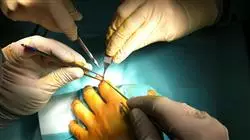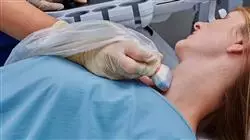University certificate
The world's largest faculty of nursing”
Introduction to the Program
Thanks to this 100% online Masters Degree, you will be able to provide top-quality assistance in trauma procedures and optimize patients' long-term quality of life”

The rehabilitation process in trauma care not only involves the physical recovery of the patient but also their adaptation to the temporary or permanent limitations resulting from the injury. In this context, the nursing professional plays a crucial role, as they are responsible for health education, treatment adherence, and emotional support for the patient. Implementing self-care strategies, along with effective coordination with physiotherapists and other healthcare professionals, is essential for improving the patient's functional recovery. However, the lack of standardized protocols and variability in care can negatively impact clinical outcomes.
For this reason, TECH Global University launches a revolutionary Masters Degree in Trauma Nursing. The academic itinerary covers content from primary care to specialized care, including emergency services, hospitalization units, and the operating room, which is often the most complex and least understood area, addressed holistically with the collaboration of various specialists. The program includes videos and clinical cases.
This program is designed to provide online instruction that equips students with both theoretical and practical knowledge, presented through high-quality multimedia content, expert-developed clinical case analysis, master classes, and video techniques. These resources enable the exchange of knowledge and experiences, maintaining and updating the professional level of participants, creating action protocols, and disseminating the most significant updates in the field. Through the online learning format, students will be able to organize their time and learning pace according to their personal schedules and will have access to the content from any computer or mobile device.
This university qualification will instill a sense of security in your nursing practice, helping you to grow both personally and professionally”
This Masters Degree in Trauma Nursing contains the most complete and up-to-date scientific program on the market. The most important features include:
- The development of practical cases presented by experts in Nursing
- The graphic, schematic, and practical contents with which they are created, provide scientific and practical information on the disciplines that are essential for professional practice
- Practical exercises where the self-assessment process can be carried out to improve learning
- Special emphasis on innovative methodologies in medicine includes theoretical lessons, questions to the expert, debate forums on controversial topics, and individual reflection work
- Content that is accessible from any fixed or portable device with an Internet connection
You will provide specialized care in the post-operative phase of orthopedic and trauma surgeries, facilitating the recovery of patients.”
The program features a faculty composed of professionals from the field of Trauma Nursing, who bring their work experience to the program, as well as renowned specialists from leading societies and prestigious universities.
The multimedia content, developed with the latest educational technology, will provide the professional with situated and contextual learning, i.e., a simulated environment that will provide an immersive learning experience designed to prepare for real-life situations.
This program is designed around Problem-Based Learning, whereby the student must try to solve the different professional practice situations that arise throughout the program. For this purpose, the professional will be assisted by an innovative interactive video system created by renowned and experienced experts.
You will administer medications and analgesic therapies to patients with musculoskeletal injuries, ensuring proper pain management”

A curriculum based on the revolutionary Relearning methodology, which will allow you to consolidate complex concepts with efficiency and dynamism”
Why study at TECH?
TECH is the world’s largest online university. With an impressive catalog of more than 14,000 university programs available in 11 languages, it is positioned as a leader in employability, with a 99% job placement rate. In addition, it relies on an enormous faculty of more than 6,000 professors of the highest international renown.

Study at the world's largest online university and guarantee your professional success. The future starts at TECH”
The world’s best online university according to FORBES
The prestigious Forbes magazine, specialized in business and finance, has highlighted TECH as “the world's best online university” This is what they have recently stated in an article in their digital edition in which they echo the success story of this institution, “thanks to the academic offer it provides, the selection of its teaching staff, and an innovative learning method aimed at educating the professionals of the future”
A revolutionary study method, a cutting-edge faculty and a practical focus: the key to TECH's success.
The most complete study plans on the university scene
TECH offers the most complete study plans on the university scene, with syllabuses that cover fundamental concepts and, at the same time, the main scientific advances in their specific scientific areas. In addition, these programs are continuously being updated to guarantee students the academic vanguard and the most in-demand professional skills. In this way, the university's qualifications provide its graduates with a significant advantage to propel their careers to success.
TECH offers the most comprehensive and intensive study plans on the current university scene.
A world-class teaching staff
TECH's teaching staff is made up of more than 6,000 professors with the highest international recognition. Professors, researchers and top executives of multinational companies, including Isaiah Covington, performance coach of the Boston Celtics; Magda Romanska, principal investigator at Harvard MetaLAB; Ignacio Wistumba, chairman of the department of translational molecular pathology at MD Anderson Cancer Center; and D.W. Pine, creative director of TIME magazine, among others.
Internationally renowned experts, specialized in different branches of Health, Technology, Communication and Business, form part of the TECH faculty.
A unique learning method
TECH is the first university to use Relearning in all its programs. It is the best online learning methodology, accredited with international teaching quality certifications, provided by prestigious educational agencies. In addition, this disruptive educational model is complemented with the “Case Method”, thereby setting up a unique online teaching strategy. Innovative teaching resources are also implemented, including detailed videos, infographics and interactive summaries.
TECH combines Relearning and the Case Method in all its university programs to guarantee excellent theoretical and practical learning, studying whenever and wherever you want.
The world's largest online university
TECH is the world’s largest online university. We are the largest educational institution, with the best and widest online educational catalog, one hundred percent online and covering the vast majority of areas of knowledge. We offer a large selection of our own degrees and accredited online undergraduate and postgraduate degrees. In total, more than 14,000 university degrees, in eleven different languages, make us the largest educational largest in the world.
TECH has the world's most extensive catalog of academic and official programs, available in more than 11 languages.
Google Premier Partner
The American technology giant has awarded TECH the Google Google Premier Partner badge. This award, which is only available to 3% of the world's companies, highlights the efficient, flexible and tailored experience that this university provides to students. The recognition as a Google Premier Partner not only accredits the maximum rigor, performance and investment in TECH's digital infrastructures, but also places this university as one of the world's leading technology companies.
Google has positioned TECH in the top 3% of the world's most important technology companies by awarding it its Google Premier Partner badge.
The official online university of the NBA
TECH is the official online university of the NBA. Thanks to our agreement with the biggest league in basketball, we offer our students exclusive university programs, as well as a wide variety of educational resources focused on the business of the league and other areas of the sports industry. Each program is made up of a uniquely designed syllabus and features exceptional guest hosts: professionals with a distinguished sports background who will offer their expertise on the most relevant topics.
TECH has been selected by the NBA, the world's top basketball league, as its official online university.
The top-rated university by its students
Students have positioned TECH as the world's top-rated university on the main review websites, with a highest rating of 4.9 out of 5, obtained from more than 1,000 reviews. These results consolidate TECH as the benchmark university institution at an international level, reflecting the excellence and positive impact of its educational model.” reflecting the excellence and positive impact of its educational model.”
TECH is the world’s top-rated university by its students.
Leaders in employability
TECH has managed to become the leading university in employability. 99% of its students obtain jobs in the academic field they have studied, within one year of completing any of the university's programs. A similar number achieve immediate career enhancement. All this thanks to a study methodology that bases its effectiveness on the acquisition of practical skills, which are absolutely necessary for professional development.
99% of TECH graduates find a job within a year of completing their studies.
Master’s Degree in Trauma Nursing
In primary and specialized care, treating certain pathologies that affect the musculoskeletal system requires essential skills for the correct assessment and examination of the extremities. At TECH Global University, we have developed this Master's Degree in Trauma Nursing with the aim of providing healthcare professionals with a comprehensive range of knowledge necessary to enhance their daily clinical practice. The curriculum covers everything from recommendations for medical history taking to the care required for various complications: spinal syndromes, trauma to the upper/lower limbs, and musculoskeletal tumorations. Special attention is given to the specifications of emergency, hospitalization, and operating room care, all of which are critical to patient management. Additionally, the program places a strong focus on ortogeriatrics and their specific considerations.
Advanced clinical practice in Trauma Nursing
Enrolling in this Master's degree is an excellent opportunity to develop expertise in assisting with and utilizing conservative, rehabilitative, and surgical procedures. The program covers topics such as limitations in mobility due to stiffness and ankylosis, inflammatory processes, infections, and pain management strategies. With an approach that combines theoretical and practical learning, including case analysis, students will internalize the knowledge organically, gaining greater confidence and proficiency when applying treatments. This program also prepares professionals to manage programs focused on the prevention and promotion of musculoskeletal health, ensuring patient safety in all environments. Furthermore, students will be trained in standardized care plans, especially for hospitalized patients. The Master's Degree in Trauma Nursing strengthens the practical knowledge of nurses, ensuring their ability to handle clinical cases of patients admitted for traumatic conditions.







